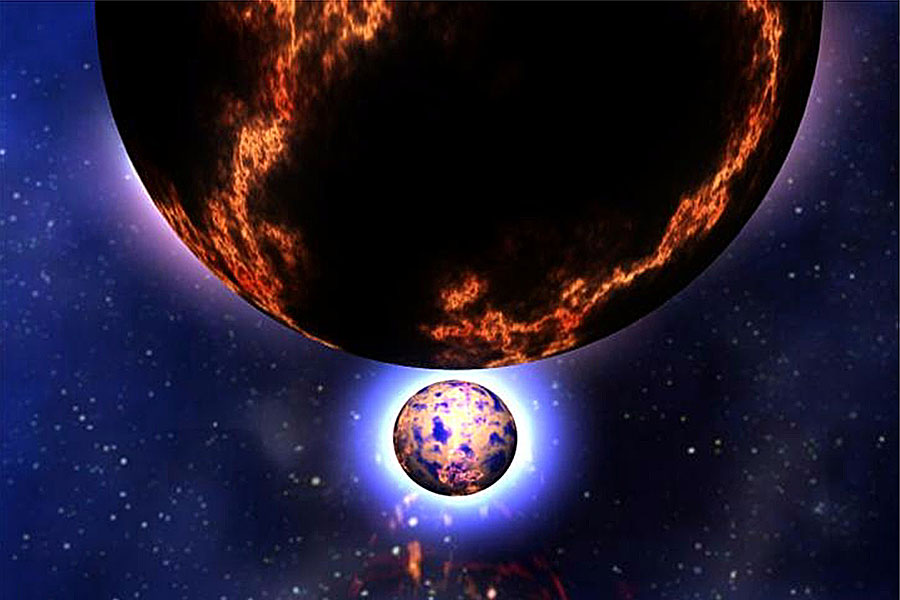
On the Origin of Gold
Illustration Credit : Dana Berry, NASA
Posted on 05/18/2008 8:08:19 AM PDT by sig226

Explanation: Where did the gold in your jewelry originate? No one is completely sure. The relative average abundance in our Solar System appears higher than can be made in the early universe, in stars, and even in typical supernova explosions. Some astronomers have recently suggested that neutron-rich heavy elements such as gold might be most easily made in rare neutron-rich explosions such as the collision of neutron stars. Pictured above is an artist's illustration depicting two neutron stars spiraling in toward each other, just before they collide. Since neutron star collisions are also suggested as the origin of short duration gamma-ray bursts, it is possible that you already own a souvenir from one of the most powerful explosions in the universe.

Here in Fairbanks there is some interest in gold as a minable resource. Wondering one day how it came to be that gold was concentrated here in Fairbanks I asked a geologist and got a blank look for answer. It is, that’s all, it just is!
On the Discovery Channel an astrophysics guru was stating that the collision of two galaxies would likely result in zero star collisions, so how do they explain the frequency of neutron star collisions?
Binary star systems which are very common.
So why would they collide? Objects orbiting each other don't generally have collisions do they? The Earth and our Moon come to mind.
Tidal forces cause them to slowly spiral toward each other. The Moon is gradually getting closer to the earth.
I'm not expert, but everything I've read indicates the opposite. i.e. The Moon has gotten and is getting farther from the Earth.
And wouldn’t two stars entering a death spiral start mixing atmospheres long before collision, thus avoiding the big collision discussed? The near sides would experience much reduced gravity and be blown into the space between, no?
It could be viewed in a couple different ways, but the moon is departing. Whether it is in fact already past the point of no return might be interesting to look at. It is in fact already gone, has achieved escape velocity, is a planet on its own. Bu-bye.
Looks like you are right! HMMMM! I'll have to do some research.
I wuz wrong about the moon, but binary stars can and do merge,......
http://en.wikipedia.org/wiki/Binary_stars
Most interesting.
They don't. Proxima Centauri is 4.2 lightyears away and is our nearest neighbor. There is enough distance for another star to pass between us without seriously disturbing either system. In order for a stable system to decay into a collision, a third object would have to be involved. Or the colliding object could be a runaway star, possibly liberated when another multiple system broke down.
Interestingly, the study of mass extinctions led to the belief that we've suffered massive comet impacts about every 27,000,000 years. This could happen if we had an undetected binary star and it's orbit dislodged objects from the Kuiper Belt at this interval. Some astronomers are taking the suggestion seriously enough to look for the object. And if there are two massive objects circling the solar system, we may be screwed. :)
It occurs to me that you could dislodge 10,000 comets and send them toward the sun and the likelihood of a direct impact on Earth would still be statistically unlikely. Thus, for the "every 27,000,000 years" theory to hold up mathematically, a truly dizzying number of objects would have to be sent in.
That’s why the idea leads to the need for another star to get close enough to the Kuiper Belt to knock enough comets loose to ensure a strike. From what I read, the astronomers stated that nothing else could do it, and that it is possible we failed to observe that star.
Disclaimer: Opinions posted on Free Republic are those of the individual posters and do not necessarily represent the opinion of Free Republic or its management. All materials posted herein are protected by copyright law and the exemption for fair use of copyrighted works.